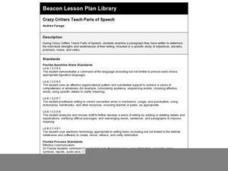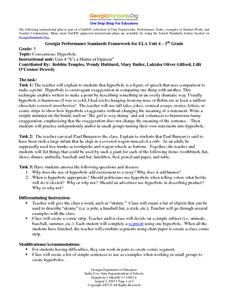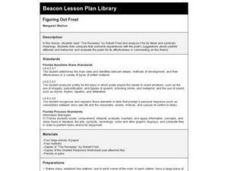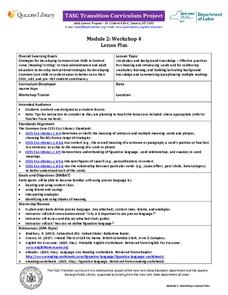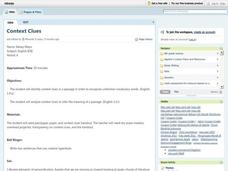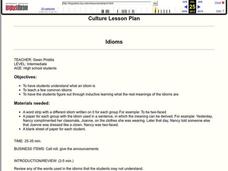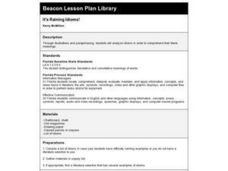Curated OER
It's Raining Cats and Dog: Studying Idioms
Seventh graders determine the literal and figurative meanings of idioms and research the history of idioms. In this idioms activity, 7th graders read two books by Fred Gwynne and select two idioms from the texts to research. Students...
Curated OER
Crazy Critters Teach Parts of Speech
Young scholars create pieces of writing about a creature they have created. They examine the parts of speech and how they are used in their writing to see how they can write more specifically.
EngageNY
Grade 11 ELA Module 2: Unit 1, Lesson 22
Say precisely what you mean. Scholars analyze the importance of Washington's precise language in paragraphs eight and nine of the "Atlanta Compromise" speech. They interpret his figurative language and add it to their Idea Tracking...
EngageNY
Grade 10 ELA Module 2: Unit 3, Lesson 4
It is, and it is not. Scholars examine how these words impact Eleanor Roosevelt's speech, in which she tries to persuade the adoption of the Universal Declaration of Human Rights. Readers note rhetoric and figurative language. They then...
Curated OER
Figuratively Writing...It's for the Birds!
Learners identify and use literary devices such as personification, idioms, hyperbole, and metaphors. They identify one literary device and illustrate the meaning. They write a letter using correct letter format and incorporates literary...
Curated OER
Conventions: Hyperbole
Fifth graders discuss hyperbole. In this language arts instructional activity, 5th graders understand that hyperbole enables writers to make a point by describing something in an overly dramatic way. Students create a list of objects...
Curated OER
Understanding Idioms
Students explore figurative language. In this idioms lesson, students research the origin of instructor-selected idioms. Students literally interpret the idioms. Interpretations are photographed and then presented to the class.
Curated OER
Figuring Out Frost
Fourth graders read "The Runaway" by Robert Frost and analyze it for its literal and symbolic meanings. They compare their personal experiences with the poet's suggestions about youthful attitudes and behaviors. Some nice worksheets are...
Curated OER
Railroad Idioms Art Lesson Plan
Sixth graders research railroad idioms. In this idiom activity, 6th graders read through a glossary of different railroad idioms and their meanings. They illustrate a chosen idiom.
Curated OER
Common Idioms 1
In this language arts worksheet, pupils learn that idioms are spoken or written sentences where the meaning is not obvious. Students match the 10 idioms to their meanings.
New York State Education Department
TASC Transition Curriculum: Workshop 4
Why is it important to use precise language? Participants explore this question in the fourth activity in a series of 15 on effective instruction. Perfect for all content areas, the activity promotes appropriate language choice through...
Curated OER
Pre-AP Strategies for Spanish Literature
Take a break from vocabulary development and have your Spanish scholars immerse themselves in Spanish culture. What are common Spanish proverbs? In short sessions over the course of a few weeks, the class will learn about different...
Curated OER
The Outsiders
Tenth graders complete a variety of activities related to the first two chapters of the book The Outsiders. They define metaphor, simile, idiom, and hyperbole, and take a vocabulary pre-quiz. In small groups, they write a character...
Curated OER
Context Clues
Work on context clues with your ninth graders in this lesson, which focuses on identifying and analyzing clues to define unfamiliar words. They identify context clues in a passage to recognize words they haven't seen before, and then...
Curated OER
A Creative Presentation
Bring writing to life with this lesson in which elementary and middle schoolers create a display of the imagery they identify in a series of Gary Paulsen books. They read the suggested materials, identify imagery and descriptive...
Curated OER
Interesting Idioms
Students are introduced to the topic of idioms in figurative speech. Using the definition of idioms, they use literature to view examples. They identify idioms in different forms of writing and practice using them in speech. ESL...
Curated OER
Idiom Games
Students identify idioms as groups of words with special meanings that paint a mental picture for the reader.They compete in a game in which they draw and interpret pictures of idioms.
Curated OER
Idioms...not the be taken literally!
Students define common English idioms which they find in books and book excerpts. They use an idiom dictionary and constuct a database of five idioms along with meanings and sentences. They beam this information to classmates.
Curated OER
Idioms
Students explore the use of common idioms and deduce the correct meanings of idioms.
Curated OER
It's Raining Idioms!
Sixth graders analyze idioms and find examples from literature. They choose one idiom and finds pictures or draws pictures to show what it would mean if taken literally and what is it generally thought to mean.
Curated OER
Idioms
Students examine the use of idioms in everyday language. They discuss the meanings of various idioms, complete a worksheet, and create a poster to illustrate a selected idiom.
Curated OER
Idioms
Students study the meanings of idioms containing the phrase "up" or "down." In this language lesson, students are given an online scenario where the idiom phrases are used. Students answer multiple choice questions about their meaning.
Curated OER
You Don't Say!!
Fourth graders write and respond to sayings throughout the school year. They define the idioms, illustrate them and compare their meanings with other groups in the class.
Curated OER
ACROSTIC POETRY
Students use newspapers or magazines to create an acrostic poem where words are divided into parts of speech.

